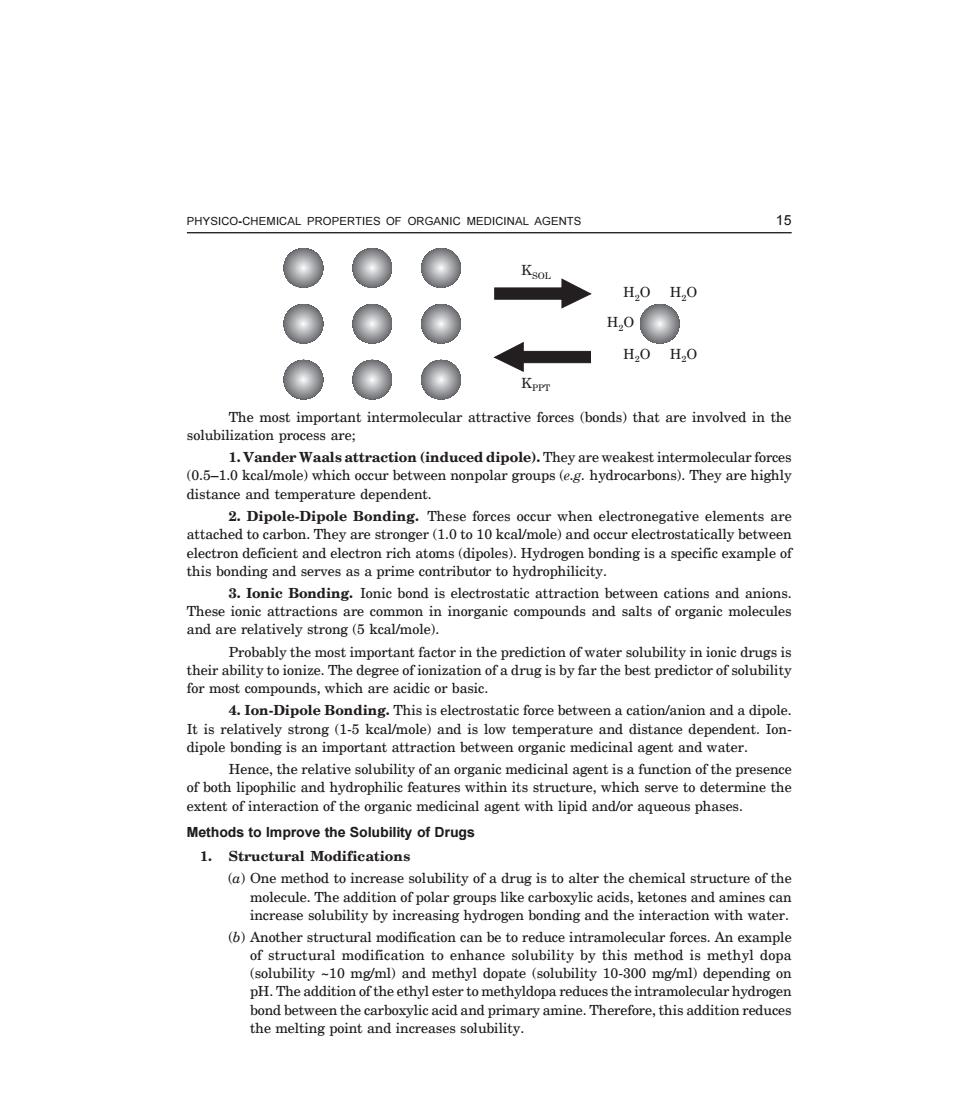正在加载图片...

PHYSICO-CHEMICAL PROPERTIES OF ORGANIC MEDICINAL AGENTS 15 H,0H,0 H.O H,0H,0 The most important intermolecular attractive forces (bonds)that are involved in the solubilization process are; 1.Vander waals attraction (induced dipole).They are weakest intermolecular force (0.5-1.0 kcal/mole)which occur between nonpolar groups (e.g.hydrocarbons).They are highly distance and temperature dependent. electr egative nents ar are str and ele cally betweer ing is a specific exampleo ng and 3.Ionic Bonding.Ionic bond is electrostatic attraction between cations and anions These ionic attractions arecommo in inorganic compounds and salts of organic molecules and are relatively strong(5 kcal/mole). Probably the most important factor in the t their ability to ionize.The degree of ionization of a drug is by far the best predictor of solubility for most compounds.which are acidic or basic. 4.Ion-Dipole Bonding.This is electrostatic force between a cation/anion and a dipole g(1-5k mn and is1o endent.Ion mn ater. e re of both philic d cina agent i n of rophilicfe n organic med es wit 1 e the extent of interaction of organic medicinal e,wh and/or aqueous phases Methods to Improve the Solubility of Drugs 1.Structural Modifications (a)One method to increase solubility of a drug is to alter the chemical structure of the nereaesohbitybyinOTorgnee molecule The addition of polar rboxylic acids.keto nd o ogen bonding and the interaction with water Anothe ion can be to 1 ce thy e s.A od i p ng H The ethyl est r hy the melti the int and in ses solubility. ary amine.The saddition rePHYSICO-CHEMICAL PROPERTIES OF ORGANIC MEDICINAL AGENTS 15 C-8—N-CHEMI\CHE3-1.PM5 KSOL KPPT H O2 H O2 H O2 H O2 H O2 The most important intermolecular attractive forces (bonds) that are involved in the solubilization process are; 1. Vander Waals attraction (induced dipole). They are weakest intermolecular forces (0.5–1.0 kcal/mole) which occur between nonpolar groups (e.g. hydrocarbons). They are highly distance and temperature dependent. 2. Dipole-Dipole Bonding. These forces occur when electronegative elements are attached to carbon. They are stronger (1.0 to 10 kcal/mole) and occur electrostatically between electron deficient and electron rich atoms (dipoles). Hydrogen bonding is a specific example of this bonding and serves as a prime contributor to hydrophilicity. 3. Ionic Bonding. Ionic bond is electrostatic attraction between cations and anions. These ionic attractions are common in inorganic compounds and salts of organic molecules and are relatively strong (5 kcal/mole). Probably the most important factor in the prediction of water solubility in ionic drugs is their ability to ionize. The degree of ionization of a drug is by far the best predictor of solubility for most compounds, which are acidic or basic. 4. Ion-Dipole Bonding. This is electrostatic force between a cation/anion and a dipole. It is relatively strong (1-5 kcal/mole) and is low temperature and distance dependent. Iondipole bonding is an important attraction between organic medicinal agent and water. Hence, the relative solubility of an organic medicinal agent is a function of the presence of both lipophilic and hydrophilic features within its structure, which serve to determine the extent of interaction of the organic medicinal agent with lipid and/or aqueous phases. Methods to Improve the Solubility of Drugs 1. Structural Modifications (a) One method to increase solubility of a drug is to alter the chemical structure of the molecule. The addition of polar groups like carboxylic acids, ketones and amines can increase solubility by increasing hydrogen bonding and the interaction with water. (b) Another structural modification can be to reduce intramolecular forces. An example of structural modification to enhance solubility by this method is methyl dopa (solubility ~10 mg/ml) and methyl dopate (solubility 10-300 mg/ml) depending on pH. The addition of the ethyl ester to methyldopa reduces the intramolecular hydrogen bond between the carboxylic acid and primary amine. Therefore, this addition reduces the melting point and increases solubility